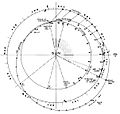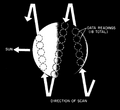Mariner 2 facts for kids

Depiction of Mariner 2 in space
|
|
| Mission type | Planetary flyby |
|---|---|
| Operator | NASA / JPL |
| Harvard designation | 1962 Alpha Rho 1 |
| Mission duration | 4 months, 7 days |
| Spacecraft properties | |
| Spacecraft type | Mariner based on Ranger Block I |
| Manufacturer | Jet Propulsion Laboratory |
| Launch mass | 202.8 kilograms (447 lb) |
| Power | 220 watts (at Venus encounter) |
| Start of mission | |
| Launch date | August 27, 1962, 06:53:14 UTC |
| Rocket | Atlas LV-3 Agena-B |
| Launch site | Cape Canaveral LC-12 |
| End of mission | |
| Last contact | January 3, 1963 7:00 UT |
| Orbital parameters | |
| Reference system | Heliocentric |
| Perihelion | 105,464,560 kilometers (56,946,310 nautical miles) |
| Epoch | December 27, 1962 |
| Flyby of Venus | |
| Closest approach | December 14, 1962 |
| Distance | 34,773 kilometers (18,776 nautical miles) |
|
|
|
Mariner 2 was a special spacecraft built by NASA. It was part of the Mariner program, which sent probes to other planets. Mariner 2 made history as the first spacecraft from Earth to successfully visit another planet.
Contents
Mariner 2's Journey to Venus
Mariner 2 began its journey on August 27, 1962. It launched from Cape Canaveral Air Force Station on an Atlas-Agena B rocket. The main goal of Mariner 2 was to fly past the planet Venus.
Scientists wanted to learn many things about Venus. They hoped to gather information about its atmosphere (the gases around it). They also wanted to study its magnetic field, the particles around it, and its total mass.
On December 14, 1962, Mariner 2 got closest to Venus. It was about 34,773 km away. This was a very important moment for the mission.
Later, on December 27, the spacecraft reached its closest point to the Sun. This point is called perihelion. It was 105,464,560 km from the Sun. The last time we heard from Mariner 2 was on January 3, 1963. Even today, Mariner 2 is still orbiting the Sun.
How Mariner 2 Was Designed
The design of Mariner 2 was exactly like that of Mariner 1. Mariner 1 was the first spacecraft in the Mariner program. However, Mariner 1 had a problem shortly after launch. Its path was wrong, so it had to be destroyed.
Because of this, Mariner 2 became the second spacecraft to launch. It used the same successful design. This helped ensure its mission could go forward.
What Mariner 2 Discovered About Venus
Mariner 2 sent back amazing information about Venus. It found that the surface of Venus is extremely hot. The temperature was at least 425 °C (797 °F). This heat was the same on both the day and night sides.
The spacecraft also discovered something surprising. Venus spins in the opposite direction compared to most planets in our Solar System. It also learned that Venus's atmosphere is mostly carbon dioxide. The pressure on the planet's surface is very high.
Mariner 2 saw that Venus is always covered by thick clouds. But it did not find any magnetic field around Venus. The mission also taught us about space itself. It found that the solar wind (particles from the Sun) is always flowing. It also showed that there is much less cosmic dust between planets than near Earth.
Images for kids
-
Mariner II trajectory projected on the ecliptic plane.
See also
 In Spanish: Mariner 2 para niños
In Spanish: Mariner 2 para niños











